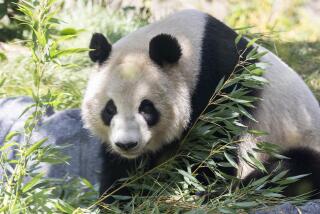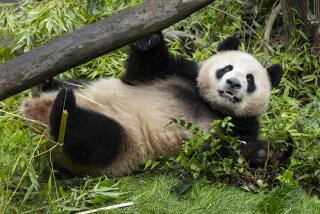Twins Born to Popular San Diego Zoo Panda
- Share via
SAN DIEGO — Hua Mei, the giant panda born five years ago at the San Diego Zoo and one of its most popular animals ever, has given birth to twins in her ancestral China.
Both mother and cubs were reportedly in good shape at the Wolong Giant Panda Breeding and Research Center in Sichuan province in the hours after the birth. The cubs, roughly the size of sticks of butter, weigh about 4 ounces each. One is male; the gender of the other hasn’t been determined.
The births were another hopeful sign for efforts by both countries to revive the endangered species, zoo officials said Wednesday. Although there is dispute about the numbers, the panda population in their native China is thought to have dwindled to near extinction.
Hua Mei was transferred to Wolong in February to breed. Her leave-taking occasioned considerable sorrow in San Diego, where the mating, naming and maturing of the zoo’s pandas is the subject of intense public and media interest.
Chinese officials arranged for Hua Mei to engage in “significant bouts of mating” with Ling Ling and to be artificially inseminated with sperm from Shaun Shaun, both proven studs. Until blood tests are done on the cubs, their paternity is unknown. But Don Lindburg, the zoo’s panda team leader who recently visited Wolong, is betting on Ling Ling.
One result of the San Diego-China collaboration has been development of what panda specialists call the “olfactory priming” system for encouraging mating among pandas.
The reasons for the pandas’ population decline, besides poaching and destruction of habitat, include the idiosyncrasies of the female reproductive system and the scratchy relationship between male and female pandas.
The males and the females, which are not known to like each other much, often fight. The female is in season for only a few days a year. Plus, in captivity, males have been known to lose interest in mating.
To overcome these problems, San Diego panda specialists developed a system whereby males and females are brought in proximity through a fence during the female’s annual estrus. This allows the male to smell the female and become interested.
“They’re still solitary animals, but we found that if they can get chemical information from [smelling] each other, it helps with arousal,” Lindburg said. “This works much better than throwing two animals together cold turkey.”
Hua Mei is the offspring of Shi Shi and Bai Yun, who were sent from China to San Diego in 1996 under a 12-year loan agreement, amid considerable hoopla and delicate geopolitical wrangling. When Shi Shi showed no interest in mating, Bai Yun was artificially inseminated.
Shi Shi was later returned to China in exchange for Gao Gao, a younger, more virile male. Last year Bai Yun was mated with Gao Gao and artificially inseminated by Shi Shi.
When a male cub, Mei Sheng, was born last August, blood tests showed Gao Gao to be the sire, reinforcing the view that natural mating is more likely to succeed than artificial methods.
Among the roughly 4,000 animals at the San Diego Zoo, there is no dispute that its pandas are its most popular attraction, leading to the phrase “panda-monium” and pandas being dubbed “charismatic mega-vertebrates.”
To satisfy the craving of true panda fans, the zoo has a “panda cam” on the Internet, although it comes with a warning that the black-and-white animals can be hard to see in the dark. In the past year, the panda cam has recorded 9 million hits, far outpacing cams for elephants, apes and polar bears.
Until Hua Mei’s much publicized departure, the zoo had a family of four: dam (Bai Yun), sire (Gao Gao), male cub (Mei Sheng), and female cub (Hua Mei). None of the three other zoos in the U.S. that have pandas have more than a pair.
Under the agreement between the zoo and the Chinese government, all panda cubs born in San Diego must be sent to China after three years. The San Diego Zoo contributes $1 million a year to panda conservation efforts in China.
To the delight of her fans, Hua Mei’s departure was delayed for more than a year as officials ironed out details about transportation and other concerns. And as her days in the U.S. dwindled, patrons crowded the panda grotto for a long goodbye.
At Wolong, 11 of 12 females have become pregnant this year, officials said. Less than a decade ago the pregnancy rate was only a third. “The birthrate is up,” Lindburg said.
Indeed, just this week at Wolong, Leilei gave birth and then a few hours later, another panda, known only as No. 20, also gave birth, according to the official Xinhua News Agency. Another cub, born last week to Eryatou, died despite efforts to save its life with traditional Chinese herbal medicines.
Hua Mei’s twins present challenges, Lindburg said. Multiple births are common among pandas -- one estimate is that 47% of pregnancies end in twins or triplets -- but, in the wild it is rare for more than one cub to survive.
One theory is that the mother panda, knowing that life is rough for a panda in the wild, ignores one cub and lavishes her attention and milk on the other. To try to save both cubs, Wolong panda specialists are ready with a special milk formula.
“We hear that Hua Mei is a very involved mother,” Lindburg said, “and has already tried to hold the cubs.”
More to Read
Sign up for Essential California
The most important California stories and recommendations in your inbox every morning.
You may occasionally receive promotional content from the Los Angeles Times.










